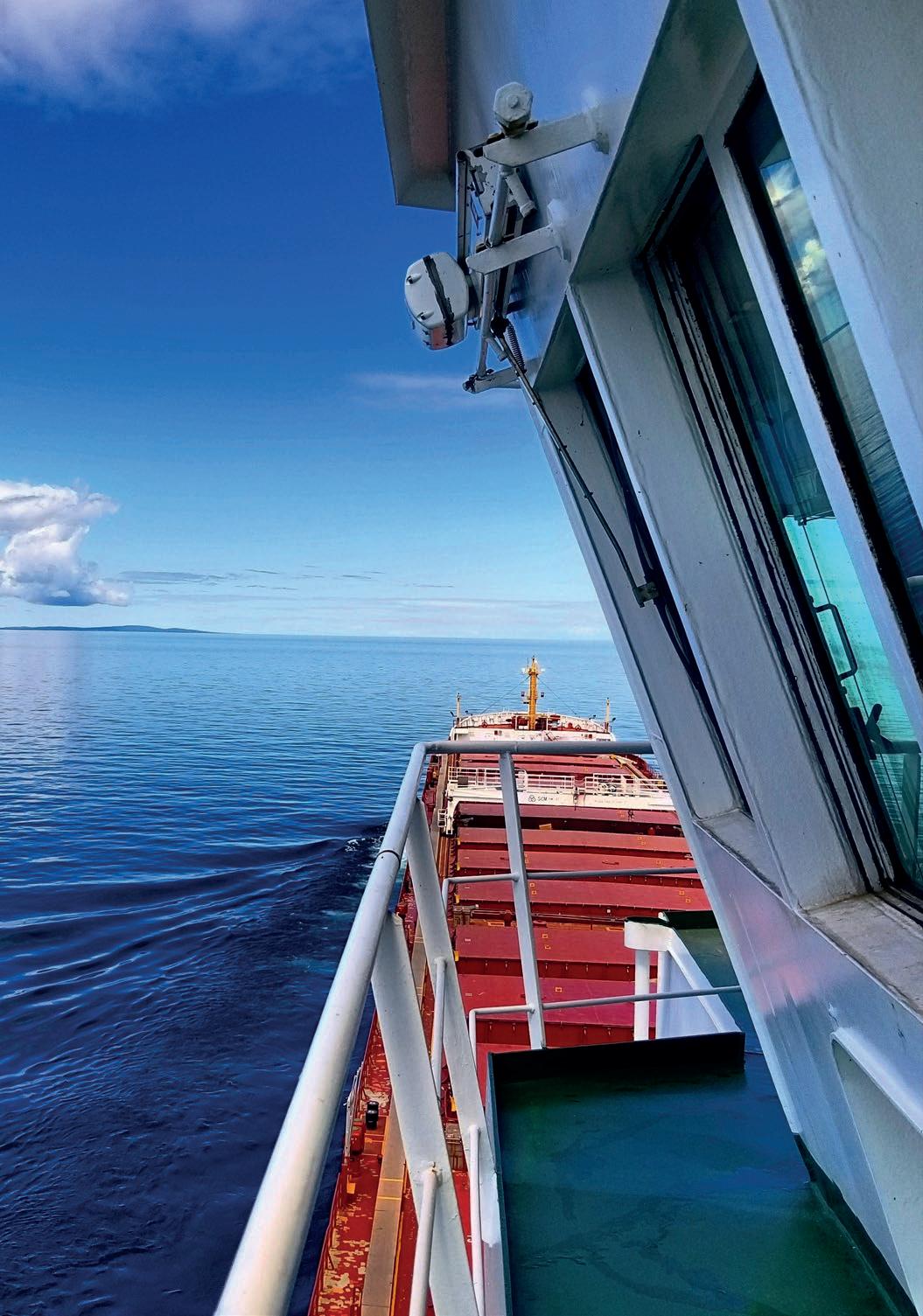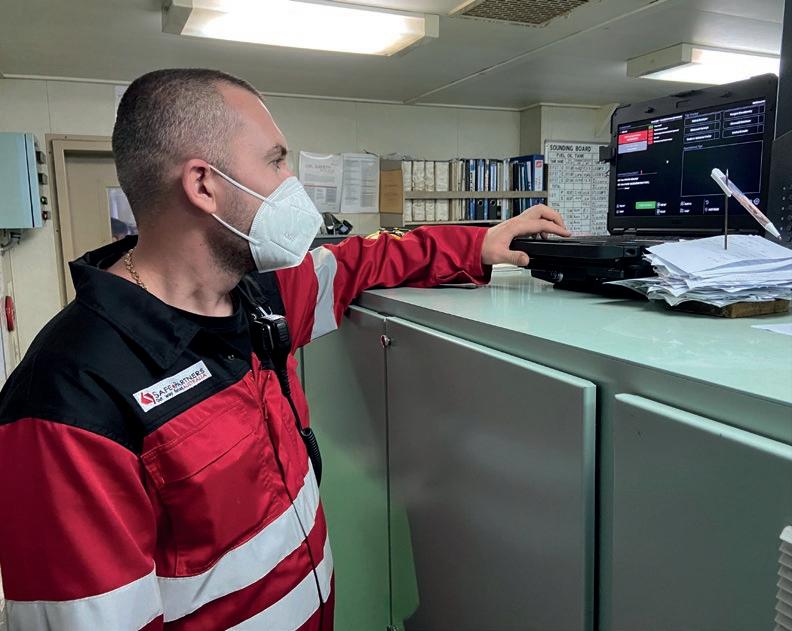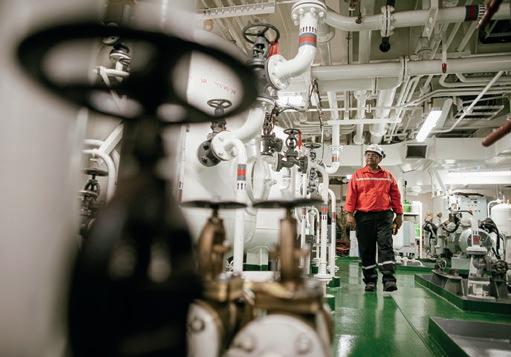
8 minute read
Decarbonization
Reducing carbon emissions and avoiding the worst consequences of climate change is a global imperative. At CSL, we recognize our responsibility not only for decarbonizing our own operations, but also for working with our partners to encourage deep decarbonization along the value chain.
As we continue to work to achieve net-zero shipping, we know our success in decarbonizing our operations relies on our customers’ willingness to embrace carbon-neutral transport as a value-added product.
Advertisement
CSL’s Biodiesel Program Gains Traction

CSL’s Biodiesel Program in Numbers
Eight-vessel trial
from May to October 2021 More than 27,000 hours
burning B100 biodiesel More than 16,000 MT of biodiesel B100 delivered More than 38,478 MT of carbon avoided on a life-cycle basis To achieve decarbonization in the maritime industry at the scale and speed required to meet the goals of the Paris Agreement, we need to adopt solutions for the existing shipping fleet to reduce our greenhouse gas emissions. To this end, CSL began a biodiesel demonstration project in 2019 on one vessel’s auxiliary engine, progressing to the main and auxiliary engines of two ships in 2020. In 2021, we rolled out our biodiesel project to eight ships. Our pilot project has demonstrated the technical feasibility of using biodiesel to power existing marine engines.
ESTABLISHING A LEVEL PLAYING FIELD
CSL is working closely with different levels of government to establish durable, long-term and competitive decarbonization strategies for the marine sector. New regulations must be region-specific and take into account the size and assortment of local fleets. They must include incentives to increase the production of biodiesel and other measures to ensure that the cost of alternative fuels remains competitive.
A lifecycle perspective is an important part of the decision-making process for adopting alternative fuels. CSL wants to make sure the options we explore don’t have unintended negative consequences up or down the value chain. A lifecycle greenhouse gas (GHG) accounting process evaluates and reports on full lifecycle GHG emissions associated with the raw materials extraction, manufacturing or processing, transportation, use, and end-of-life management of a good or service. CSL’s biodiesel supply originates in North America and is produced from the waste soy oil left from processing the soy plant for animal feedstock. We evaluated the biodiesel supply using the government of Canada’s GHGenius Lifecycle Emissions Model, a lifecycle emissions inventory tool. According to this measure, using biodiesel can reduce GHG emissions by more than 80 percent, compared to fossil fuels.
80%
Improving Propeller Efficiency
As part of CSL’s energy efficiency upgrades, we have installed propeller boss fin caps on selected vessel propellers as well as Becker Mewis Ducts®, devices attached to the hull in front of the propeller to help improve fuel efficiency.
The propeller boss fin caps work by eliminating the hub vortex generated by the rotating propeller, requiring less power to propel the vessel at a given speed. The Becker Mewis Duct® straightens and accelerates the hull wake into the propeller to produce more thrust, hence requiring less energy to maintain a given speed. In 2021, sister ships CSL Koasek and CSL Kajika were fitted with Becker Mewis Ducts®, bringing the total number of ships in the fleet with energy saving hull appendages to 10.
10
Energy-saving hull appendages installed across the fleet


REAL-TIME ENERGY EFFICIENCY MONITORING
CSL’s proprietary Operational Optimizer (O2) energy management system leverages onboard sensors and fuel flow meters to provide the crew with real-time, accurate information on vessel performance. In addition to aiding energy efficient operations on board vessels, O2 data helps us compare vessel performance against sister ships and historical benchmarks.
This information helps us make the best possible decisions to increase the energy efficiency of our ships. Our scheduling teams can also use the system to predict estimated times of arrival at the next port and to support just-in-time arrival, a concept that is gaining traction globally as a tool with significant potential to improve the overall efficiency of the shipping sector.
In 2021, we continued to install O2 hardware and sensors in our Australia and Americas fleets, despite the challenges the ongoing COVID-19 pandemic presented. We intend to have O2 hardware and sensors connected and running on the entire fleet by late 2022.
CAPTURING DATA USING A DIGITAL TWIN
A significant aspect of CSL’s O2 system concerns the digitization of vessel data. We use a digital twin on shore to capture and archive system data and crew inputs. We add voyage, geofencing, traffic, compliance, weather and user inputs to data collected on vessels and combine this data for our onshore analytics.
Hydrogen Injection R&D
As part of our research and development efforts to reduce greenhouse gas emissions, CSL has been exploring hydrogen injection fuel systems. In 2021, we investigated two systems that looked promising. The first system involves injecting hydrogen into a vessel’s main engine. The second system involves a mix of hydrogen and methanol. Both technologies improve fuel consumption and engine fuel efficiency.
If the systems were able to use renewable forms of hydrogen and methanol, they could help reduce greenhouse gases even further. In 2022, we will continue to look at possible trial projects using these fuel injection systems.
DRAFT OPTIMIZATION THROUGH RADAR MEASUREMENTS
Measuring a ship’s draft is crucial to enable crew to load cargo to the vessel’s maximum safe limit. Radar measurements show promise in providing crews with more precise readings of a ship’s draft. In 2021, we worked with a partner to install radar measurement equipment on board one vessel in the fleet as part of a trial. In 2022, we plan to activate the system to maximize onboard cargo space and improve overall efficiency.
EFFICIENCY IN CARGO TRANSPORTATION
Ships move approximately 80 percent of the world’s goods. When compared to other forms of transportation, marine shipping is the most energy-efficient mode of moving cargo. As shown in the graph below, transporting cargo on CSL’s global fleet is 10 times more efficient than moving cargo by truck, and 55 times more efficient than sending cargo by air.
5.54
7.90
14
80
0 100 200
300 Grams of CO2eq per tonne-km 400 435
500
Based on the IMO GHG 2009 study. Trucks >40 tonnes – Bulk Carriers 10,000 – 34,999 DWT.
CSL 2030 Goal
How did we do?
Achieved a 26 percent reduction of CO2eq per tonne of cargo moved in 2021 compared to 2005.
Achieved an annual
reduction of 2.6 percent
for total GHG emissions per tonne-nautical mile.
Achieved 86 percent of our 2030 goal to reduce 35 percent of GHG emissions emitted in 2005 per tonne of cargo moved.
Shore Power Feasibility Study
In mid-2021, CSL began studying the feasibility of using shore power at Australian ports for our coastal fleet, rather than generating power from the ship’s engines while docked.
The marine industry has studied the use of shore power and associated technology on an array of vessel types, ports and trades, and this trend is being adopted globally. CSL Australia’s pneumatic cement fleet lends itself well to the use of shore power because the ships call at port regularly and because of their fuel consumption during unloading operations. These vessels call weekly (sometimes biweekly) at the ports of Melbourne and Sydney and use fuel when running the onboard pneumatic unloading system. Using shore power not only reduces the quantity of fuel a vessel burns, it also cuts air emissions and vessel noise, thus minimizing the impact of cargo operations on surrounding communities. Utilizing green shore power will also contribute to CSL’s compliance under the upcoming 2023 MARPOL regulations. As part of our shore power study, CSL is liaising with customers and external stakeholders, including port and government authorities, to understand the infrastructure requirements, both on board and on shore. In 2022, CSL will work towards having our pneumatic fleet and eventually our hybrid self-unloaders use shore power.
KEY COMPONENTS OF ONSHORE POWER SUPPLY
Main Incoming Station Power Cables Shoreside Substation Berth Onboard Installation
FREON ELIMINATED FROM CSL FLEET
CSL has successfully eliminated Freon, an aerosol propellant and ozone-depleting substance, from our fleet, well ahead of our 2030 target. We achieved this reduction by systematically removing all refrigerant gases (R22 and R409A, also known as Freon) from onboard systems during scheduled vessel dry docks. In 2021, we removed Freon from the last vessel in the fleet. Removing Freon will continue to be a mandatory requirement for any future vessels we acquire.

CSL 2030 GOAL PROGRESS IN 2021 MOVING FORWARD
Produce 35 percent less CO2eq per tonne of cargo moved than in 2005
Reduce fleet sulphur emissions by 95 percent compared to 2010 Eliminate ozone-depleting refrigerants from the fleet Eliminated ozone depleting refrigerant gases R22 and R409A from the fleet
Utilized B100 biodiesel on eight vessels Installed one propeller boss fin cap and two Becker Mewis Ducts®
Deployed O2 on CSL Australia and CSL Americas vessels
Trimmed the propeller on one vessel
Completed energy efficiency lighting upgrades on six ships Upgraded Eco-Torque on four vessels Expand the use of biodiesel on the CSL fleet
Trial draft optimization radar technology on one ship Complete a shore power feasibility study in all CSL operating regions Trim one more propeller and upgrade two Eco-Torques









